The Ultimate H. Biology Midterms Study Guide
1/85
There's no tags or description
Looks like no tags are added yet.
Name | Mastery | Learn | Test | Matching | Spaced |
|---|
No study sessions yet.
86 Terms
what is the shape of dna?
what are the four nitrogenous bases in dna?
what are the three parts of dna?
double-helix
adenine, thymine, cytosine, guanine
phosphate group, deoxyribose sugar, nitrogenous base
what is the shape of RNA called?
what are the four nitrogenous base of RNA?
what are the three parts of RNA?
single helix
adenine, thymine, cytosine, uracil
phosphate group, ribose sugar, nitrogenous base
what are the differences between chromosome, chromatin, and chromatid?
chromosome is two strands of tightly compacted DNA, chromatin is loosely compacted DNA, and chromatid is just half a chromosome
how are nucleic acids connected to each other?
what kind of bonds are present between sugars and phosphates?
what kind of bonds are present between the bases?
which bond do we want to break?
they are connected via phosphate group through the 5’ to the 3’
covalent bond
hydrogen bond
hydrogen bond
what does adenine pair with? how many hydrogen bonds does it create?
thymine, 2
what does cytosine always pair with? how many hydrogen bonds does it create?
guanine, 3
what are the differences between nucleotides, DNA, genes, chromatin, and chromosomes?
Nucleotides are the monomers of DNA, while DNA is a long strand of nucleotides. Chromatin is a uncoiled and unorganized DNA, while chromosomes are organized and coiled up DNA. Genes are contained within chromosomes and they help code for our physical traits.
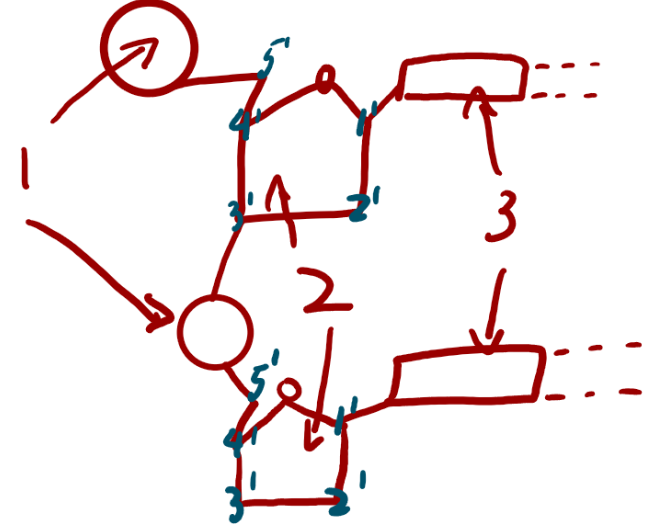
label the parts of a DNA nucleotides.
1. phosphate group
2. deoxyribose sugar
3. nitrogenous base
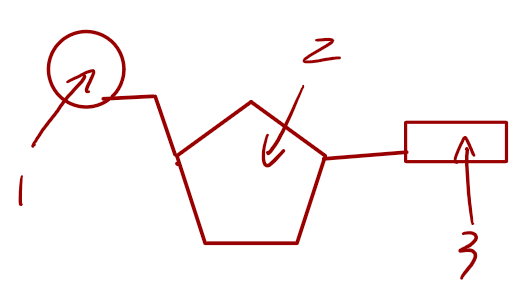
label the parts of a RNA nucleotide
1. phosphate group
2. ribose sugar
3. nitrogenous base
where does DNA replication occur?
when does it occur?
what are some of the reasons a cell needs replication?
in the nucleus
in the synthesis phase of interphase
growth, repair, replace, reproduce
how does DNA replication occur?
first, DNA helicase first unzips the DNA by breaking the hydrogen bonds, creating the replication fork.
second, RNA primase adds a primer that marks the starting point for the creation of DNA.
third, DNA polymerase binds to the primer and adds new nucleotides w/ complementary bases to the parent strand in the 5’ to 3’ direction. the leading strand continuously works, while the lagging strand is created in okazaki fragments. they are anti-parallel.
fourth, exonucleases removes the primers and DNA polymerase fixes any mistakes in the base pairs.
fifth, DNA ligase seals the okazaki fragments of the lagging strand
finally, two identical DNA strands are created
what is transcription? where is it performed? what is the purpose?
what is translation? where is it performed?
turning DNA code into RNA code, in the nucleus, to send the message to the t-RNA and ribosomes
turning RNA code into protein, in the ribosome, to create proteins from m-RNA instructions
what are the three types of RNA and what are their uses?
mRNA, takes DNA code out of the nucleus
tRNA, brings specific amino acids to the ribosome based on mRNA code
rRNA, reads the mRNA code and matches it to a tRNA anticodon
what is the process of protein synthesis?
first, RNA polymerase will add the complementary RNA bases to DNA, creating mRNA
second, the mRNA leaves the nucleus and attaches itself to a ribosome
third, tRNAs will carry an amino acid to the ribosome, and inside of the ribosome it matches the codon to the tRNA’s anticodon. once it finds its match, it attaches itself to the codon and releases the amino acid. the tRNA will leave to pick up another amino acid, while the methionine will attach itself to another attached amino acid via a peptide bond. the tRNA will attach to another amino acid, and the cycle repeats.
finally, this process will repeat until it receives the stop codon.
how are the processes of transcription and DNA replication similar?
they both happen in the nucleus, they both need the DNA to copy off of, and they both use polymerase to create DNA and m-RNA respectively
what are the codons?
what are the anticodons?
three bases of m-RNA that act as information
three bases of t-RNA that act as an identifier for specific amino acids

label the diagram from a to j
a. DNA
b. bases
c. RNA polymerase
d. m-RNA
e. cell membrane
f. nuclear pore
g. t-RNA
h. amino acid
i. ribosome
j. proteins
"workers” that deliver amino acids
t-RNAs
organelle that directs translation
ribosome
it’s like “a name tag” for a tRNA
anticodon
holds the master code for building proteins
DNA
three bases which represent a certain amino acid
codons
these are carried by t-RNAs to a ribosome
amino acids
travels from the nucleus to the cytoplasm
m-RNA
a completed chain of amino acids
proteins
a place where ribosomes are active
cytoplasm
a place where DNA can be found
nucleus
what molecule are referred to as “epigenetic tags” that turn off genes? what does it do?
what molecule are referred to as “epigenetic tags” that turn on genes? what does it do?
methyl group, it adds cytosine in the DNA and makes that gene less acceptable for transcription
acetyl group, it loosens the chromatin and causes gene activity to increase
how do identical twins become more and more different physically as they age, even though they have identical DNA.
Through their experience in life, their epigenomes change how their genes are expressed, and the environment factors also affect their appearance or health. For example, sleep, diet, and exercise can change their physical health
what does imprinting mean?
epigenetic tags that are ingerited by children from their parents
What is the definition of biology?
the study of life from the simplest forms (unicellular) to the most complex forms (multicellular)
what are the 7 characteristics of life?
1. they are made up of cells with DNA
2. they can grow and develop
3. they can reproduce (a/sexually)
4. they can respond to stimuli
5. they can acquire and use energy
6. can maintain homeostasis
7. can evolve as a population
what are the 7 steps of the scientific method?
1. identify a problem
2. research
3. make a hypothesis
4. conduct an experiment
5. collect data
6. analyze and conclude
7. repeat and replicate
what are the differences between independent and dependent variables in an experiment?
independent variables is the factor you change during the experiment, while the dependent variable is what is the result of the change and what is measured in the experiment
what are the differences between a control group and an experimental group?
the experimental group is the group that gets tested on, while the control group doesn’t get tested
what are the different ways we can organize data from our research?
tables, line, bar, pie graph

label the parts of an atom.
1. nucleus
2. neutron
3. proton
4. electron
5. electron cloud
what is a atom?
the building blocks of matter
what is a element?
a pure substance made up of only one kind of atom
what is a molecule?
two or more atoms chemically bonded together
what is an ion?
a charged atom
what are the five elements found in all living things?
carbon, hydrogen, oxygen, nitrogen, and phosphorus
what is the valence shell?
the outermost shell of the electrons which forms bonds
what are the differences between an ionic bonds and a covalent bond?
ionic bonds transfer electrons from one atom to another, while covalent bonds share electrons together
how do you determine how many covalent bonds an atom can have?
1. count how many electrons the atom has
2. subtract two for the inner shell
3. count how many electrons it needs to complete its outer shell (usually 8 electrons, or 2 for hydrogen)
what is a hydrogen bond
a weak bond that occurs between polar molecules due to unequal shared electrons with hydrogen

label the parts of the water molecule and the covalent and hydrogen bonds
1. hydrogen molecule
2. oxygen molecule
3. hydrogen bonds
4. covalent bonds
what are the properties of water?
1. cohesion
2. adhesion
3. biologic solvent
4. density changes when water changes forms
5. high heat capacity
6. evaporative cooling
how are polymers formed and broken down by?
they are formed via dehydration synthesis, while they are broken down by hydrolysis
what are the monomers of carbohydrates?
what elements make up carbohydrates?
what are the functions of carbohydrates?
what are some molecular examples?
monosaccharide
carbon, hydrogen, oxygen
provides quick energy
glucose, sucrose, fructose, starch, glycogen, cellulose/fiber, chitin
what are lipid monomers?
what elements make up lipids?
what are the functions of lipids?
what are some molecular examples?
triglyceride
carbon, hydrogen, very little oxygen
provides long-term energy storage, insulation, making cell membranes
hormones, phospholipids, vitamin A, D, K
what are the different types of lipids?
saturated fats (animal based), unsaturated fats (plant based), trans fats (man-made)
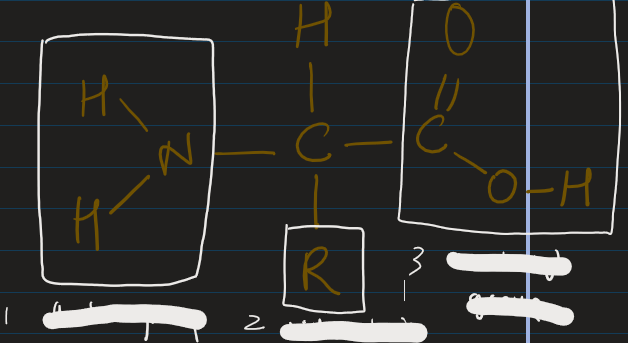
label all the parts of an amino acid structure
1. amino group
2. side chain
3. carboxyl group
what are protein monomers?
what elements are proteins made up of?
what are some functions of proteins?
what are some molecule examples of proteins?
amino acid
carbon, hydrogen, oxygen, nitrogen, sometimes sulfur
creates muscle tissue, skin, nail, and hair
collagen, insulin, actin/myosin, hemoglobin, enzymes
how to proteins work?
they must have a specific shape
what are the different groups of amino acid structures?
primary, secondary, tertiary, quaternary
what are nucleic acid monomers?
what elements are nucleic acid made up of?
what are the functions of nucleic acid?
what are some molecule examples?
nucleotide
carbon, hydrogen, oxygen, nitrogen, phosphorus
instructions to build proteins, stores genetic info
DNA, RNA
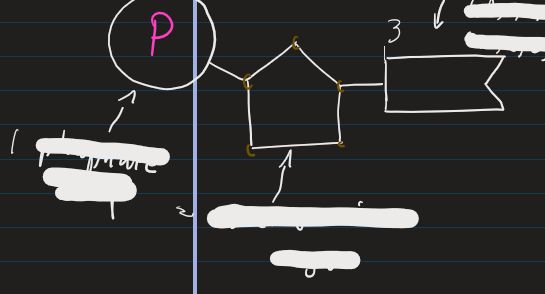
label the parts of a nucleotide
1. phosphate group
2. deoxyribose group
3. nitrogen base
what are the nitrogen bases for DNA and RNA?
adenine, cytosine, guanine, thymine for DNA
adenine, cytosine, guanine, uracil for RNA
what happens if an enzyme is put into low pH?
it is denatured, rendering it useless
which biomolecule mostly makes up the plasma membrane?
lipids
how to you test simple sugars content?
how do you test starch contents?
how do you test protein contents?
how do you test lipid contents?
benedict’s solution, it turns orange
iodine, it turns black
biuret’s solution, it turns dark purple
brown paper, it will turn translucent
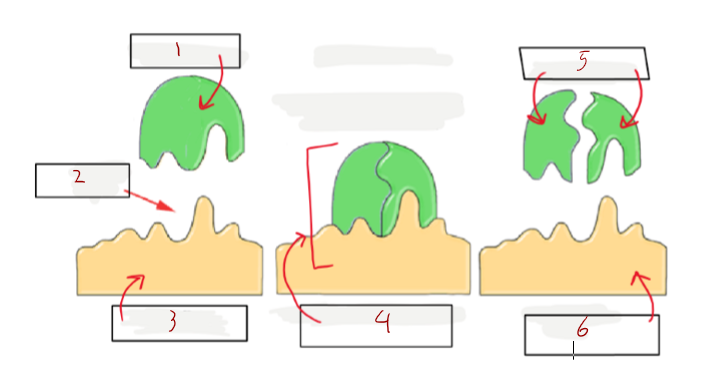
label the diagram below
1. substrate
2. active site
3. enzyme
4. substrate-enzyme complex
5. product
6. enzyme
why are enzymes specific?
the enzymes can only produce one chemical reaction. the substrate must fit in the active site to trigger the reaction.
why are enzymes reusable?
the enzymes aren’t consumed in the reactions so they can be used over and over again
what is a prokaryote?
what are some examples of a prokaryote?
a cell without a nucleus
bacteria or archaea cells
what is a eukaryote?
what are some examples?
a cell with a nucleus
plant, animal, fungi, and protist cells
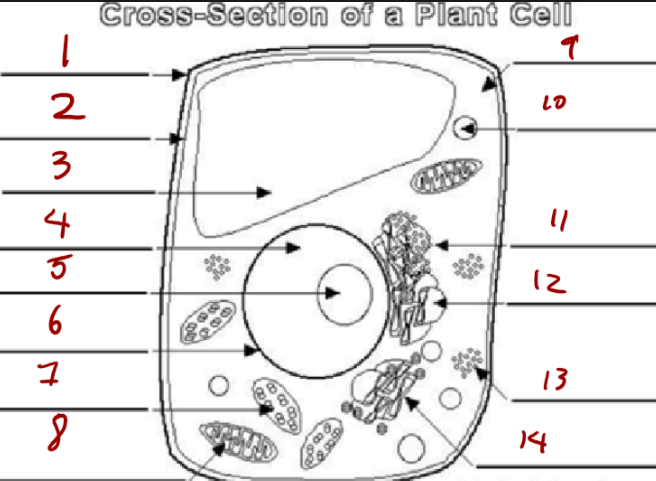
label and state the function of each organelle
1. cell wall, support and protects cell
2. cell membrane, allows material to enter and exit the cell
3. central vacuole, stores water
4. nucleus, stores genetic information
5. nucleoid, stores most of the genetic information
6. nuclear membrane, contains DNA and nucleolus
7. chloroplasts, carries out photosynthesis to create sugar
8. mitochondria, carries out cellular respiration to create ATP
9. cytoplasm, holds organelles in place
10. amyloplasts, stores starch
11. rough ER, creates proteins that are shipped out by golgi apparatus
12. ribosomes, creates proteins based on DNA instructions
13. golgi apparatus, transports proteins to the cell membrane

label and state the function of the organelles
cell membrane, allows material in and out of cell
waste
nucleus, stores genetic information
nucleoid, stores most of the DNA
nuclear membrane, contains DNA and nucleolus
vacuoles, stores food and water
mitochondria, carries out cellular respiration to create ATP
centrioles, helps with cell division
cytoplasm, holds organelles in place
rough ER, creates proteins that are shipped by golgi apparatus
smooth ER, detoxifies the cell and creates lipids
ribosomes, creates proteins
golgi apparatus, transports proteins to the membrane
compare and contrast plant, animal, and bacterial cells
plant cells have a cell wall, chloroplasts for photosynthesis, and large central vacuoles, while animal cells lack a cell wall and chloroplasts but have more flexible shapes. they both are eukaryotic. bacteria cells are prokaryotic, and they lack a lot of organelles. plant and animal cells are larger and more complex, while bacteria cells are smaller and more simpler. all three cells have a cell membrane, cytoplasm, and cytoskeletons.
what is osmosis?
what is transported during osmosis?
is it passive or active energy?
does it move from high -> low or low -> high?
the diffusion of water across a cell membrane
water
passive
high -> low
what is diffusion?
what is transported?
is it passive or active energy?
does it move from high -> low or low -> high?
movement of molecules where is moving from high concentration to low concentration
molecules or particles
passive
high -> low
what is endocytosis?
what is transported?
is it passive or active?
does it move from high -> low or low -> high?
when molecules are absorbed and turned into a vesicle
large particles or substances
active
low -> high
what is exocytosis?
what is transported?
is it passive or active?
does it move from high -> low or low -> high?
when molecules are released out of the cell
large particles or substances
active
high -> low
what does hypertonic mean? what is the effect on animal cells? what is the effect on plant cells?
more solute outside of cell
dries out animal cell
dries out plant cell
what does isotonic mean? what is the effect on animal cell? what is the effect on plant cell?
equal amount of solute in and out of the cell
animal cell stays normal
plant cell is flaccid
what does hypotonic mean? what is the effect on animal cell? what is the effect on plant cell?
more solute inside of the cell
animal cell swells
plant cell is normal
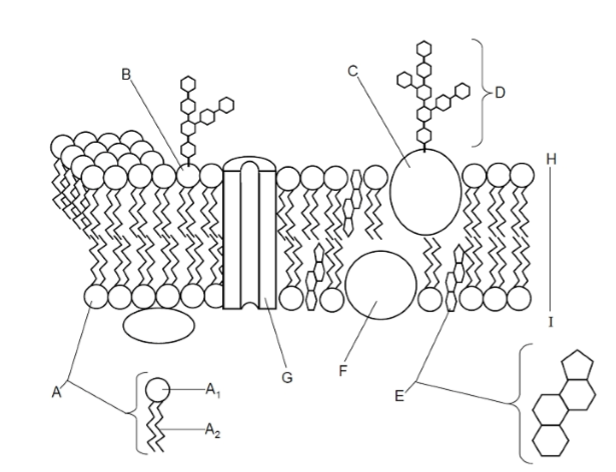
label the parts from a-g below. state their function.
a. phospholipid, provide structure to membrane
a1. phosphate (polar) head, is hydrophilic and helps form membrane
a2. lipid (non-polar) tail, is hydrophobic and controls what enters and exit the membrane
b. glycolipid, changes the fluidity of the membrane
c. glycoprotein, serve as recognition markers
d. glucose
e. cholesterol, helps stabilize membrane
f. membrane proteins, send and receive signals from outside the cell or serve as anchors
g. transport protein, helps carry substances across the membrane or allow molecules to pass through a channel
h. outside the cell
i. inside the cell
what is the difference between integral, peripheral, and surface proteins?
integral proteins help transport substances in and out of the cell or act as channels. peripheral proteins help with signaling and supporting the membrane
surface proteins help with cell recognition and communication with other cells.
describe what happens during exocytosis using an example.
exocytosis lets insulin be released from the pancreas and move into the bloodstream
describe what happens during endocytosis using an example.
endocytosis allows the WBC to absorb the bacteria, protecting the body from infections
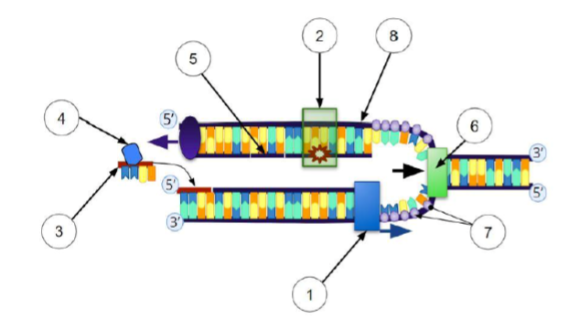
label the diagram.
1. DNA polymerase
2. ligase
3. primer
4. RNA primase
5. okazaki fragment
6. DNA helicase
7. nucleotides
8. parent strand
what are the purines?
what are the pyrimidines?
adenine, guanine
cytosine, thymine

label the diagram
1. nucleus
2. neutron
3. proton
4. electron
5. electron cloud
list the properties of water
1. cohesion
2. adhesion
3. universal solvent
4. solid form is lighter than liquid form
5. high heat capacity
6. evaporative cooling